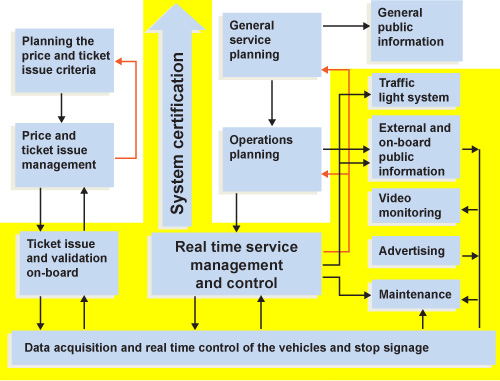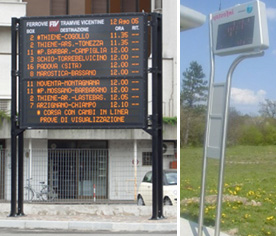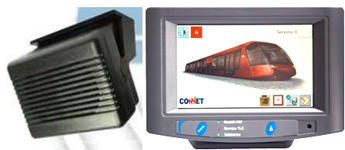Try out the monitoring and supervision system of a real PV system right now,
in real time
Mobility
The AVM (Automatic Vehicle Monitoring) system is fundamental in public transport computer systems, giving the needed technological support to numerous activities and functions involving the transport company, the user and even the public.
The AVM application initially focused on Automatic Vehicle Location – AVL, but now covers a much broader sphere integrating the various on-board and ground subsystems.
It is a valuable tool to provide a
quality, efficient and safe service and for controlling and measuring the service performance.
The area that is directly involved with the AVM system is shown in yellow. The system may be gradually and even only partially implemented, depending on the priority of each installation.
The
CONNET system has shown its worth as the
best investment for transport companies, due to its open and modular architecture which easily evolves to include other new functions
- The single components can evolve as new technology is introduced
- Interface with current and future equipment and systems of other parties
The system is basically composed of
- Control center
- On-board equipment in the vehicles
- Stop signage equipment
- Possible infrastructures in the depots
- Communications infrastructure
On-board passengers
On-board audiovisual systems tell the passengers about the service, informing them of the next stops and any special events linked to the service which could affect it (temporary route diversions, suspended stops, etc.).
Moreover, additional tourist and advertising information could also be given, providing an additional source of income for the company.
Ground passengers
Passengers waiting at the stops are informed by signage displays about the next vehicle to arrive, the planned time and expected time of arrival.
Once again, advertising information could also be incorporated.
Information may also be distributed via WEB, automatic answering service and text (SMS).
On-board staff
The driver and on-board staff are constantly updated about the service (early, late arrivals, timetable, etc.).
They are able to send and receive service and emergency messages by means of either the on-board terminal or telephonically.
Ground staff
The state of the service can be viewed on special user interfaces and maps, they are able to send and receive service messages to and from specific vehicles or groups, or all, of the vehicles either by the on-board terminal or telephonically. They are able to manage the service rescheduling, vehicle maintenance and use according to availability.
On-board safety
Safety is guaranteed by means of an on-board camcorder surveillance system.
External clients and internal controllers
Analytical data is provided for each service, which can be compared with the scheduled service to obtain certification.
Data about events justifying the failure to respect the scheduled service.
Summary and aggregated reports can be prepared.
Other functions for company controllers and users
The on-board ticket stamping machines are linked to the on-board system to enable applying the correct pricing system for the zones and for downloading all the transactions in the operations centre. Further information can also be obtained from fixed or movable passenger counters on-board, which provides a real time and statistical analysis of the passenger flows. Other vehicle information includes the vehicle and equipment diagnostics, the working hours and kilometres. Generally, the on-board system guarantees “transparent” communications from the central stations to the various installed subsystems, such as ticket issue.






